The Elephant Conservation Center works on the preservation of the Lao elephant population, both wild and those under human care. With the former increasingly under pressure (poaching, deforestation…) and the latter declining due to ageing, over-exploitation and illegal exports, solutions are urgently needed.
We must secure a healthy population of elephants under human care to act as a genetic reservoir if the wild elephant population were to collapse. To achieve this, we need improved veterinary care and elephant welfare regulations so as to increase the birth rate.
We also need to secure natural habitats for wild populations and captive elephants suitable for rewilding. This is what we are trying to achieve within the Nam Pouy National Protected Area.
In the years to come we will continue to develop the on-site hospital. We will also continue to invest in improved training and treatment facilities as well as our laboratory for parasitology, hormonal research, animal auto-medication, diet and reproductive research.
With the advantage of knowing the ovulation cycle of each of our female elephants, several bulls can be hired or bought to ensure a genetically diverse herd and successful breeding. Although young elephants born at the Center will not be ‘broken’ through the traditional training process to later work in logging, they will need to be controlled by their mahouts. This is achieved through positive reinforcement training.


